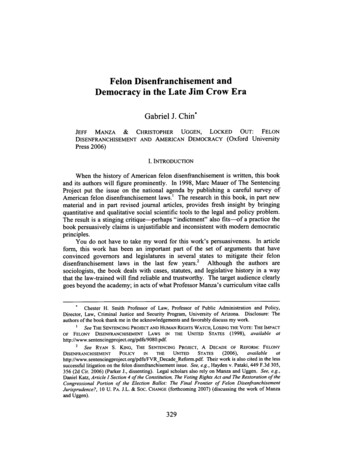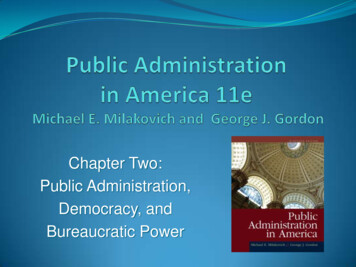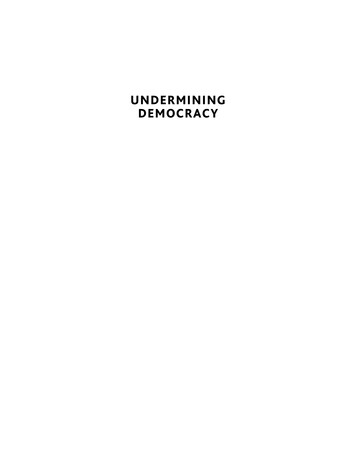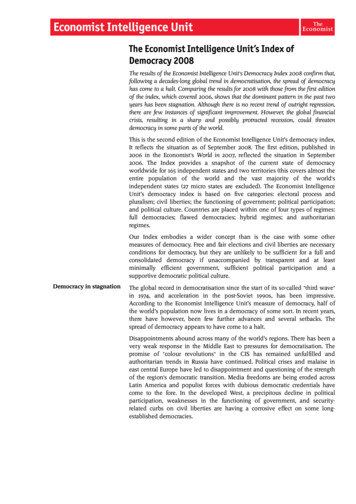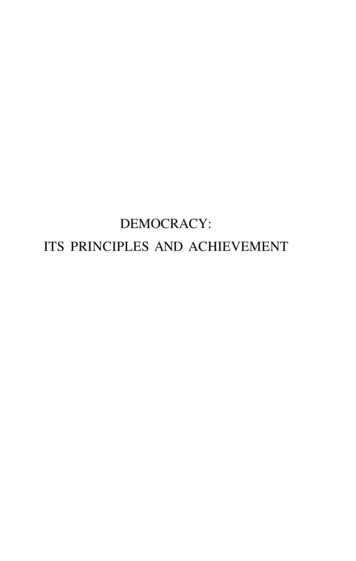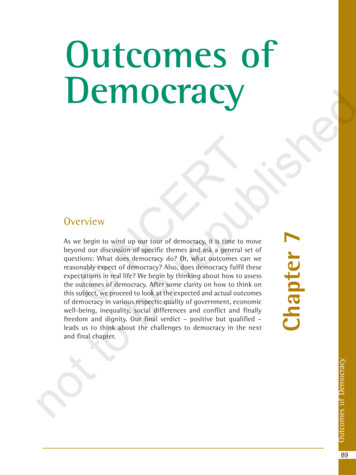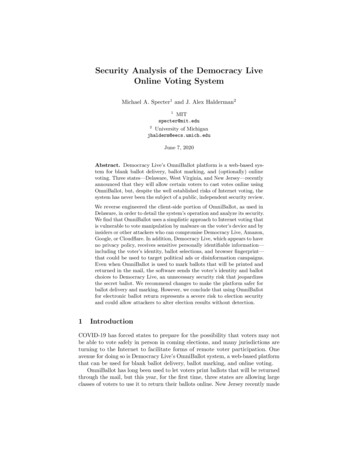
Transcription
Security Analysis of the Democracy LiveOnline Voting SystemMichael A. Specter1 and J. Alex Halderman21MITspecter@mit.edu2University of Michiganjhalderm@eecs.umich.eduJune 7, 2020Abstract. Democracy Live’s OmniBallot platform is a web-based system for blank ballot delivery, ballot marking, and (optionally) onlinevoting. Three states—Delaware, West Virginia, and New Jersey—recentlyannounced that they will allow certain voters to cast votes online usingOmniBallot, but, despite the well established risks of Internet voting, thesystem has never been the subject of a public, independent security review.We reverse engineered the client-side portion of OmniBallot, as used inDelaware, in order to detail the system’s operation and analyze its security.We find that OmniBallot uses a simplistic approach to Internet voting thatis vulnerable to vote manipulation by malware on the voter’s device and byinsiders or other attackers who can compromise Democracy Live, Amazon,Google, or Cloudflare. In addition, Democracy Live, which appears to haveno privacy policy, receives sensitive personally identifiable information—including the voter’s identity, ballot selections, and browser fingerprint—that could be used to target political ads or disinformation campaigns.Even when OmniBallot is used to mark ballots that will be printed andreturned in the mail, the software sends the voter’s identity and ballotchoices to Democracy Live, an unnecessary security risk that jeopardizesthe secret ballot. We recommend changes to make the platform safer forballot delivery and marking. However, we conclude that using OmniBallotfor electronic ballot return represents a severe risk to election securityand could allow attackers to alter election results without detection.1IntroductionCOVID-19 has forced states to prepare for the possibility that voters may notbe able to vote safely in person in coming elections, and many jurisdictions areturning to the Internet to facilitate forms of remote voter participation. Oneavenue for doing so is Democracy Live’s OmniBallot system, a web-based platformthat can be used for blank ballot delivery, ballot marking, and online voting.OmniBallot has long been used to let voters print ballots that will be returnedthrough the mail, but this year, for the first time, three states are allowing largeclasses of voters to use it to return their ballots online. New Jersey recently made
the online voting option available to voters with disabilities, calling the move “apilot for if we need to use it more broadly in the future” [26]. West Virginia allowsnot only the disabled but also military voters and residents overseas to voteonline using OmniBallot [38]. Most significantly, Delaware [23] offers OmniBallotonline voting to all voters who are sick or who are self-quarantining or socialdistancing to avoid exposure to SARS-CoV-2—practically the entire state [13,23].Increasing voter access is a laudable goal. Voters who are sick, disabled, orstationed overseas sometimes face substantial obstacles to participation, and thecoronavirus pandemic threatens to disrupt in-person voting for everyone. However,elections also face substantial risks from cyberattacks—risks that are magnifiedwhen delivering or returning ballot online. Election officials have the complicatedjob of weighing these risks in light of the access needs of their constituencies.For online voting, the consensus of election security experts and nationalsecurity experts is that the risks are unacceptable. Numerous studies of Internetvoting systems used or slated for use in real elections have uncovered criticalsecurity flaws (e.g., [25, 28, 30, 48, 49, 61]). The National Academies of Science,Engineering, and Medicine concluded that “no known technology guaranteesthe secrecy, security, and verifiability of a marked ballot transmitted over theInternet,” and that, “[a]t the present time, the Internet (or any network connectedto the Internet) should not be used for the return of marked ballots” [40]. In lightof Russia’s attacks on U.S. election infrastructure during the 2016 presidentialelection, the Senate Select Committee on Intelligence has recommended that“[s]tates should resist pushes for online voting,” including for military voters [58].As recently as May 2020, the Cybersecurity and Infrastructure Security Agency,Federal Bureau of Investigation, U.S. Election Assistance Commission, andNational Institute of Standards and Technology privately warned states that“electronic ballot return technologies are high-risk even with [risk-mitigation]controls in place,” and that attacks “could be conducted from anywhere in world,at high volumes, and could compromise ballot confidentiality, ballot integrity,and/or stop ballot availability” [60].Despite these risks, to our knowledge, OmniBallot has never been the subjectof a public, independent security review,3 and there is little public documentationabout its functionality. Democracy Live even claims that the online ballot returncapability should not be considered Internet voting at all, but rather a “secureportal” or “document storage application” [43]. (In fact, it completely matchesthe definition of Internet voting as used by security experts [1] and by the ElectionAssistance Commission [56].) These factors make it difficult for voters, electionofficials, and other policymakers to understand whether the technology is safe.In this paper, we present the first public, independent analysis of OmniBallot’ssecurity and privacy properties. We obtained the portion of the software that3Democracy Live claims that audits have been conducted by the National CybersecurityCenter (a private entity) [41] and ShiftState Security [16], though only high-levelsummaries of these audits appear to be public. NCC and ShiftState were claimed tohave performed audits of the online voting app Voatz [39], which was later found tohave basic, severe security failings [48, 52]2
runs in voters’ browsers, reverse engineered it, and created a minimal compatibleserver in order to gain insight into the system’s design and operation. UsingDelaware’s deployment as a model, we describe how the system functions, assessthe risks of its various modes of operation, and offer a series of recommendationsfor the company and for election officials. Our key findings include:1. OmniBallot’s electronic ballot return (online voting) function uses a simplisticapproach that cannot achieve software independence [44] or end-to-endverifiability [11], two key goals for secure Internet voting. It also makesextensive use of third-party services and infrastructure: the servers and voterdata are hosted in Amazon’s cloud, and the client executes JavaScript fromboth Google and Cloudflare. As a result, votes returned online can be altered,potentially without detection, by a wide range of parties, including DemocracyLive itself, insiders at any of these three large tech firms, and attackers whogain access to any of the companies’ systems or to a voter’s client.2. The OmniBallot online ballot marking mechanism as used in Delawareneedlessly risks violating ballot secrecy by sending the voter’s identity andballot selections to Democracy Live, even when the voter opts to print theballot and return it physically through the mail. There is no technical reasonwhy this information needs to be transmitted over the Internet, and someother jurisdictions have configured OmniBallot to mark the ballot client-side.3. There are important security and privacy risks even when OmniBallot isused only for delivering blank ballots, including the risk that ballots couldbe misdirected or subtly manipulated in ways that cause them to be countedincorrectly. Although these risks can be mitigated through careful electionprocedures, officials need to ensure that the necessary protections are in place,including rigorous post-election audits.4. In all modes of operation, Democracy Live receives a wealth of sensitivepersonally identifiable information: voters’ names, addresses, dates of birth,physical locations, party affiliations, and partial social security numbers.When ballots are marked or returned online, the company also receives voters’ballot selections, and it collects a browser fingerprint during online voting.This information would be highly valuable for political purposes or for electioninterference, as it could be used to target ads or disinformation campaignsbased on the voter’s fine-grained preferences. Nevertheless, OmniBallot hasno posted privacy policy, and it is unclear whether there are any effectivelegal limitations on the company’s use of the data.In this time of widespread social disruption, election officials face intensepressure to make remote voter participation easier and available to more people,but as use of online ballot delivery and return grows, so will the cybersecurityrisks—and the potential that a successful attack could change the result of amajor election. We hope that our work will be helpful for states deciding howto conduct upcoming elections in light of COVID-19, and that it will encouragefurther security scrutiny of online ballot distribution and return systems morebroadly. Without greater technical transparency and analysis, voters and electionofficials will be unable to accurately weigh the tradeoffs between risk and access.3
2A Tour of OmniBallotMuch of what is publicly known about OmniBallot comes from a small numberof sources, including a FAQ provided by Democracy Live [17], information postedon various sites for jurisdictions’ deployments (e.g., [16]), and press statements bythe company. In this section, we provide a more complete picture of the system’soperation and adoption, based on our own examination of the software.2.1Modes of OperationEach jurisdiction’s OmniBallot deployment takes the form of a website at aunique URL. The platform is highly configurable, and jurisdictions can customizethe available languages, accessibility options, voter lookup and authenticationfunctions, and available features. Most importantly, jurisdictions can configurethe platform to provide any subset of the three modes of operation listed below:Online blank ballot delivery. The voter downloads a blank ballot corresponding to their home address and/or party affiliation. The ballot is delivered asa PDF file. Most jurisdictions instruct voters to print it, mark it manually,and physically return it to the election authorities.Online ballot marking. Voters use the website to mark their ballot selectionsand download the completed ballot as a PDF file. Online marking makes iteasier for voters with certain disabilities to fill out their ballots independently.It also allows the website to prevent overvotes and to warn voters aboutundervotes, reducing errors. The resulting PDF file can be printed andreturned physically. Some jurisdictions, including Delaware, also give votersthe option to return it via email or fax.Online ballot return. In some deployments, voters can use OmniBallot tomark their ballots and transmit them to the jurisdiction over the Internetthrough a service operated by Democracy Live. Like in Washington, D.C.’sattempted Internet voting system [61], jurisdictions print the ballots theyreceive and then tabulate them with other absentee ballots.2.2DeploymentsMost instances of OmniBallot appear to be hosted at predictable paths of theform https://sites.omniballot.us/n/app, where n is the locality’s numeric FIPScode [54]. Statewide deployments use two-digit numbers, and counties and citesuse five-digit numbers. We visited all pages with these URL formats and foundinstances for seven state governments and 98 smaller jurisdictions in 11 states.Nearly all OmniBallot customers offer online ballot delivery, and we found70 that offer online ballot marking, but only a few appear to allow online ballotreturn. We found six jurisdictions that have the Internet voting option available:– https://sites.omniballot.us/41029/app (Jackson County, OR)– https://sites.omniballot.us/41059/app (Umatilla County, OR)4
––––https://sites.omniballot.us/53053/app (Pierce County, WA)https://sites.omniballot.us/kcd/app (King Conservation District, WA)https://sites.omniballot.us/54/app (State of West Virginia)https://ballot.elections.delaware.gov/app (State of Delaware)New Jersey has also announced plans to use Democracy Live for onlinevoting [37, 50] and reportedly did use it for local school board elections in May2020, but we have not located a deployment for the state.2.3The Voter’s PerspectiveWe now describe how OmniBallot works from a voter’s perspective. The screenshots in Figure 1 illustrate each step. We use Delaware’s deployment as a concreteexample, noting some of the differences in other deployments where applicable.1. Welcome. Voters visit the main URL of the website and are greeted by awelcome screen. The voter clicks a button to “Mark My Official Ballot.”2. Voter lookup. The voter enters their first and last name and date of birth,and the site locates them in the voter registration database. If multiple votersmatch, the site lists their street addresses and asks the voter to choose one.3. Verify voter. In Delaware, voters must enter the last four digits of theirsocial security numbers and a “ballot number” provided by the state throughan email sent by the election administrators. These are verified by the serverbefore the voter is allowed to proceed. Some other deployments we examineddid not use this verification step.4. Return type. Delaware lets voters opt to return their ballots by mail, by fax,by email (using a webmail portal), or through OmniBallot’s Internet votingmechanism (“electronic return”). If mail, fax, or email return is selected,voters can either mark their ballots using the site and generate PDF files toreturn or retrieve blank ballot PDFs and mark them manually.5. Ballot marking. The voter can scroll through the ballot and make selections.Write-in candidates can be entered using the keyboard where permitted. Thesite will refuse to mark more than the allowed number of candidates.6. Selection review. A summary screen shows the selections in each race (ora warning if the voter made fewer than the allowed number of sections). Thevoter can return to the ballot to change selections or proceed to casting.7. Signature. Voters are instructed to sign their names with the mouse or touchscreen, or to type their names. The result is captured as a bitmap image.Some other jurisdictions do not allow a typed signature and instruct votersthat their signature must match the signature on file with the jurisdiction.48. Electronic return. Voters are shown a preview of their return packages(which includes their identification information and signature page) and theircompleted ballot. These are PDF files that the site renders with JavaScript.4On-screen signatures often differ dramatically from signatures made on paper [19].5
(a) Welcome(b) Voter Lookup(c) Verify Voter(d) Return Type(e) Ballot Marking(f) Selection Review(g) Signature(h) Preview(i) Ballot SubmittedFig. 1: Online voting with Democracy Live, as used in Delaware. The voter’sidentity and ballot selections are transmitted over the Internet to generate aPDF ballot. Election officials later retrieve the ballot files and tabulate the votes.All screenshots in this paper were captured while using our local stand-in server.6
9. Ballot submitted. When voters are satisfied, they click a button to submitthe ballot over the Internet. In Delaware, voters can check whether a ballot intheir name has been accepted using their ballot numbers. However, unlike theconfirmations provided by E2E-V systems, this mechanism does not protectthe ballot selections from modification.Alternatively, if voters choose to download a blank ballot or to mark a ballotto send via mail, fax, or email, they follow a different path through the site.There is no signature screen after marking the ballot, and instead the voter issimply provided with a downloadable PDF file of the ballot and return package.3System Architecture and Client OperationsFrom the client’s perspective, each OmniBallot site is a single-page web app.The app is written using the AngularJS framework [8] and implemented as acombination of static HTML, JavaScript, CSS, and JSON-based configurationfiles. This code runs in the voter’s browser and performs all steps of the votingprocess via a series of API calls to services controlled by Democracy Live. Below,we explain how we performed our analysis of OmniBallot, describe the overallarchitecture of the platform, and provide details of the web app’s operation.3.1Reverse-Engineering MethodologyResearchers have conducted numerous independent analyses of electronic votingsystems by acquiring voting equipment, reverse engineering it, and testing it in acontrolled environment (see [29] and references therein). Safely testing an onlinevoting system is more challenging. Such systems necessarily have server-sidecomponents that (unless source code is available) cannot be replicated in the lab.Accessing non-public server functionality might raise legal issues and would beethically problematic if it risked unintentionally disrupting real elections [45].To avoid these issues, we constrained our analysis to publicly available portionsof the OmniBallot system. Following similar methodology to Halderman andTeague [30] and, more recently, Specter et al. [48], we obtained the client-sideOmniBallot software, which is available to any member of the public, reverseengineered it, and implemented our own compatible server in order to drive theclient without interacting with the real voting system. Of course, this approachlimits our ability to identify vulnerabilities in Democracy Live’s server-side codeand infrastructure—an important task for future work—but we were able tolearn many details about the platform’s design and functionality.For our analysis, we focused on the deployed version of Delaware’s instanceof OmniBallot, available at https://ballot.elections.delaware.gov/. As of June 1,2020, the site used OmniBallot version 9.2.11, which we believe to be the mostrecent version of the system. We began by visiting the site and saving copies ofthe files that comprise the client. We beautified [34] the minified JavaScript filesand ensured that they would not communicate with any live election services by7
Fig. 2: OmniBallot architecture. The web app runs in the browser and usesHTTPS to load files and call REST-like APIs from several domains. When votingonline or marking a ballot, the app sends the voter’s identity and ballot selectionsto Democracy Live services running in Amazon’s cloud. The app runs JavaScriptloaded from Amazon, Google, and Cloudflare, making all three companies (aswell as Democracy Live itself) potential points of compromise for the election.replacing references to *.omniballot.us domains with localhost and disablingGoogle’s services.Next, we iteratively reverse-engineered the code to understand each server APIcall and the format of the expected response, repeating this process until we couldcomplete the voting process using a local stand-in server we created. Finally, weconfirmed and extended our reconstruction of the system’s operation by inspectingHTTP traces captured by a Delaware voter while using the live system.Other than accessing resources that are available to the general public, theauthors had no interaction with the OmniBallot servers. At no point did weattempt to log in as a real voter or cast a ballot in a real election.3.2Service ArchitectureThe web app communicates with several servers to load static files or makeAPI calls, as illustrated in Figure 2. Four of these services are controlled byDemocracy Live and hosted in Amazon Web Services: {sites, published,lambda, api}.omniballot.us; all use Amazon CloudFront as a CDN and haveHTTPS certificates for *.omniballot.us. The app also loads JavaScript librariesfrom Google (Google Analytics and reCAPTCHA [3]) and Cloudflare (PDF.js).The sites and published servers appear to be backed by Amazon S3. Thesites server hosts the static HTML, JavaScript, and CSS of the web app,8
with different paths containing different jurisdictions’ deployments or differentversions of the code. The published server hosts static JSON files that specifythe configuration of each deployment (site-config.json), provide an index ofballot styles (lookups.json), and define each ballot. The site-config.jsonfile defines the appearance and workflow of the web app, allowing individual appinstances to be heavily customized for each jurisdiction.The api server handles voter lookup and authentication. It provides a RESTlike API that allows clients to query for specific voter and ballot information asJSON-encoded HTTP queries and responses. The service is hosted through AWSAPI Gateway, and may be backed by an Amazon EC2 instance. The lambdaserver uses a similar API format to process ballot PDF generation requests andonline ballot return submissions, and it appears to be backed by code runningon the Amazon Lambda serverless computing platform. Calls to both serversinclude an x-api-key HTTP header set to a hard-coded value.3.3Client–Server InteractionsIn Delaware, the client-server interactions proceed along the following lines:1. The browser visits https://ballot.elections.delaware.gov/ and loads the baseHTML page, which defines the site configuration file as n and loads the app’s base code from https://sites.omniballot.us/v9 2 11/combined.js. The app dynamically loads 24 otherJavaScript modules from under the same path. It also loads the Google Analytics library from https://www.googletagmanager.com and the reCAPTCHAlibrary from https://www.gstatic.com.2. The app looks up the voter’s registration information by making a POSTrequest to https://api.omniballot.us/vr/db/voters/lookup. This request (andall later POST requests) includes headers for the reCAPTCHA API as anabuse protection mechanism. The request contains the voter’s first and lastnames and date of birth. The server responds with the registration data,including a unique id (voter id ), whether the user is a “standard” or military(UOCAVA) voter (voter type), and their party (voter party) and precinct.3. The app verifies the voter’s identity by making a POST request to https://api.omniballot.us/vr/db/voter/voter id /verify. The request includes the electionID as well as the ballot number and partial social security number enteredby the user. If verification succeeds, the server returns a signed JSON WebToken that authenticates the voter id.4. To find available elections, the app sends a GET request to https://api.omniballot.us/accounts/account id /currentelections?voter type type&voterparty party. The server returns a JSON object for each election with theelection name, ID, parent id, and opening and closing dates. The app thenlocates the appropriate ballot design by loading https://published.omniballot.us/10/parent id /styles/lookups.json, which is a data structure that associates9
Fig. 3: In Delaware, marked ballot generation takes place on OmniBallotservers. The app sends a POST request (above) that includes the voter’s identityand ballot selections. The server returns the marked ballot as a PDF file. Onlinevoting uses a similar request format, with the addition of a browser fingerprint.Marking ballots server-side increases risks to election integrity and ballot secrecy.ballot styles with precincts, parties, and voter types. The ballot itself is defined in a static JSON object retrieved from https://published.omniballot.us/10/parent id /styles/style id.json.5. If the voter chooses to return the ballot via postal mail, fax, or email, theweb app generates a ballot PDF file by making a POST request to https://lambda.omniballot.us/packagebuilder/v2. The request includes an HTTPAuthorization: Bearer header that contains the voter authentication tokenacquired above. The request body, shown in Figure 3, specifies the election,the ballot style, and the voter’s name and other registration information. Ifthe voter is marking the ballot, it also includes the ballot selections, encodedas an array of race and selection identifiers. The server returns a URL to aPDF file containing the generated ballot. The file is hosted in Amazon S3,and the URL is a pre-signed object URL [6] with a five-minute expiration.6. Online ballot return uses a similar API. The app makes a POST request tohttps://lambda.omniballot.us/ebr/build with the same authorization header.The request contains the same kinds of data as ballot marking, including thevoter’s identity, registration information, and ballot selections. In addition,the request contains a browser fingerprint generated using FingerprintJS [59]and a base64-encoded PNG image of the voter’s signature. The server returnsa ballot ID and URLs from which the client can retrieve PDF files of themarked ballot and return package. These are rendered in the browser usingthe PDF.js library, which is retrieved from cdnjs.cloudflare.com.7. Finally, to submit the ballot online, the client makes a POST request tohttps://lambda.omniballot.us/ebr/submit, again including the authorizationheader. The request contains the voter id and the ballot id from the previous10
step, but the ballot selections are not resent. Based on Democracy Live’sstatements about using Amazon ObjectLock [5], we assume that this APIcall causes the server to place the return package and ballot PDFs into anObjectLock-enabled S3 bucket for delivery to election officials. The serversends a response indicating success, and the voting process is complete.4Security AnalysisWe now assess the security and privacy risks of the OmniBallot platform. Weanalyze risks created when OmniBallot is used in each of three modes—blankballot delivery, ballot marking, and online ballot return—and we discuss how (orwhether) they can be mitigated. We consider three main classes of adversaries:Adversaries with access to the voter’s device. The client-side adversarieswith which we are most concerned are ones with the ability to alter the behaviorof the voter’s web browser, such as by modifying HTTP requests or responses orinjecting JavaScript into the context of the site. Several kinds of threat actorshave these capabilities, including system administrators, other people with whomthe voter shares the device (e.g., an abusive partner), and remote attackers whocontrol malware on the device, such as bots or malicious browser extensions.Client-side malware is especially concerning because many devices are already infected by malicious software that could be remotely updated to attackOmniBallot. For instance, Microsoft this year took down a botnet controlled byRussian criminals that had infected more than nine million PCs [46]. Botnets aresometimes rented or sold to other parties to perpetrate attacks [31]. Similarly,researchers recently uncovered more than 500 malicious Chrome extensions inuse by millions of people [32], and a popular legitimate Chrome extension washijacked and modified to forward users’ credentials to a server in Ukraine [33].Attackers could use these strategies to target large numbers of OmniBallot voters.Adversaries with access to OmniBallot server infrastructure. The platform’s architecture makes server-side adversaries extremely powerful. Dependingon which services they compromised, they could change the code delivered toclients, steal sensitive private information, or modify election data, includingvoted ballots. Potential attackers with such access include: (1) software engineersand system administrators at Democracy Live; (2) insiders at Amazon, whichowns and operates the physical servers; and (3) external attackers who manageto breach the servers or Democracy Live’s development systems.Adversaries with control of third-party code. Beyond its reliance onAmazon’s cloud, OmniBallot incorporates a wide range of third-party softwareand services, including AngularJS, FingerprintJS, PDF.js, Google Analytics, andreCAPTCHA. Since all this code runs within the app’s browser context, it hasthe ability to access sensitive data or introduce malicious behavior. In recentyears, attackers have hijacked several popular JavaScript libraries to target usersof software that incorporates them (e.g., [53]). Moreover, OmniBallot clients loadsome libraries directly from Google and Cloudflare, putting these companies (aswell as Amazon) in a position to surreptitiously modify the web app’s behavior.11
Even large, sophisticated companies are not beyond being compromised bynation states—see, e.g., Operation Aurora, in which China infiltrated Google and anumber of other high-tech companies [63]. While Amazon, Google, and Cloudflarehave significant incentives to protect their infrastructure and reputations, theyalso have large stakes in the outcome of major elections, and individual employeesor small teams within the companies may feel strong partisan sympathies andhave sufficient access to attack OmniBallot. Furthermore, even if these companies’services were perfectly secure against insiders and exploitation, voters may still bedistrustful of their ability to handle votes impartially—just as some of the publicdoes not trust the Washington Post under Jeff Bezos’s ownership—weakeningthe perceived legitimacy of elections.The subsections that follow discuss attacks that these threat actors couldcarry out against OmniBallot’s blank ballot delivery, online ballot marking, andelectronic ballot return features, and against voters’ privacy. We omit someimportant categories of attacks, including denial-of-service attacks and attacksagainst voter authentication, due to limits of what we can learn without access tothe servers or detailed local election procedures. Table 1 summarizes our analysis.4.1Risks of Blank Ballot DeliveryOmniBallot’s safest mode of operation is online del
Security Analysis of the Democracy Live Online Voting System Michael A. Specter1 and J. Alex Halderman2 1 MIT specter@mit.edu 2 University of Michigan jhalderm@eecs.umich.edu June 7, 2020 Abstract.

